
BRIEF HISTORY OF THE BARDSEA BRANCH OF THE FURNESS RAILWAYThe Conishead Priory (or Bardsea) Branch was a line of exceptional interest. This obscure branch was only 2½ miles in length, yet it possessed two passenger stations including its improbable terminus which was inaccessible to the general public; trains had to reverse to enter the branch; its passenger train service was unusually infrequent; Bradshaw timetables gave incorrect mileages for the branch stations; and it closed very early, before the ‘Grouping’ of 1923. The official name of the line, the Bardsea Branch, indicates that it was never expected to end at Conishead Priory. The line was originally intended to continue past the village of Bardsea and onward along the northern shore of Morecambe Bay to Barrow-in-Furness. WHY WAS THE BARDSEA BRANCH PROPOSED? The origin of the Bardsea Branch lay in the economic importance of the south Furness area in the 1860s-80s when the region was one of Great Britain’s principal sources of hæmatite (iron) ore and Barrow-in-Furness was rapidly expanding as a centre of iron and steel manufacture and shipbuilding, with huge coastal docks being constructed; the town’s population expanded from 3,135 in 1861 to 18,911 in 1871 and 47,529 ten years later. Railway passenger services connected an isolated network of lines in and around Barrow to the ‘West Coast main line’ from 1 September 1857 when the Ulverstone [sic] & Lancaster Railway opened, this company being acquired by the Furness Railway in 1862. A disadvantage of the route was that between Ulverston and Dalton an uphill gradient reaching 1 in 80 was encountered, then beyond the 439yd Lindal Tunnel the line descended towards Dalton for 1¾ miles at 1 in 103 / 1 in 97. Heavily loaded freight trains carrying iron ore and manufactured products struggled to breast the summit, and banking engines were often required to assist them, making the route expensive to operate and congested by slow-moving trains. To overcome this problem the Furness Railway proposed to build a double-track route from Plumpton Junction, a short distance east of Ulverston to Salthouse (Barrow) by way of Bardsea, and the company appears to have been actively preparing plans for this project in 1874; the small part of the Plumpton to Barrow loop route to be constructed was known as the Bardsea Branch. Wind of this proposal reached the press in Ulverston; Andrews (2010) includes part of the Ulverston Mirror editorial of 14 February 1872 which argues that the new line, effectively avoiding Ulverston, would take traffic away from the town causing its ‘utter ruination’ while Barrow would continue to grow and thrive.
THE ULVERSTON CANAL At the northern end of this proposed route in the environs of the old market town of Ulverston was a small area of intense industrial activity. The town had been connected to Morecambe Bay by the 1¼-mile Ulverston Canal completed in 1796, which enabled sea-going ships to reach the canal basin. Traffic along the canal grew to a peak in 1846 but declined as Barrow’s port and trade expanded.
GROWTH NEARBY OF INDUSTRY AND RAILWAYS IN 1860s-70s A goods branch (authorised on 16 July 1866) opened trailing from the down line between Plumpton Junction and Ulverston to connect the former port of Greenodd with the Ulverston Canal basin; removal of an opening span over the River Leven estuary when the line east of Ulverston had been upgraded made Greenodd inaccessible to coastal shipping. Another important development followed in 1873 when owners of various hæmatite mines in Furness decided to build an ironworks of their own. They formed the North Lonsdale Iron & Steel Co Ltd and established a plant close to the canal, and it was adjacent to, and aligned with, the intended course of the Bardsea Branch; Gilpin suggests that James Ramsden, Managing Director of the Furness Railway and the founders of the North Lonsdale ‘ironworks’ probably discussed their respective schemes. The ironworks (which never produced steel, despite the company’s name) was built during 1874. For most of its life the factory was supplied by coke from County Durham, conveyed across the Pennines via the Stainmore route. In 1874 the canal siding was extended to serve the factory. This short branch, access to which faced in the direction of Ulverston and Barrow, would not be part of the Bardsea Branch project which, as noted above, required a junction facing eastwards enabling it to be used by trains between Barrow and the West Coast main line (and vice versa). The locality to the east of Ulverston was also to include the Sandhall brickworks, Sadler’s chemical works plant (where pitch and other tar products were distilled) and a wireworks which opened after the Bardsea Branch was completed. CONISHEAD PRIORY ESTATE: A NEW VICTORIAN SUBURB OF ULVERSTON? Construction of the stately home of Conishead Priory, replacing an earlier building, began in 1821 in the grounds of what had been an Augustinan foundation. The mock-Gothic mansion was built by the Braddyll family who had amassed a fortune from their coal mines in County Durham; the ambitious project took twenty years, cost £140,000 and bankrupted the owner, Thomas Richmond-Gale-Bradyll. The mansion was auctioned in 1852 and bought by a group of cousins (one of whom, Henry William Askew of Inveraray, made it his residence) who in turn sold it in 1874.
The purchasers of the estate were described by a local magnate as ‘speculative gentlemen’: John Poole, a solicitor in Ulverston; William Gradwell, a contractor and developer; and A H Strongitharm, a civil engineer. Gradwell had constructed many buildings in Barrow (and was at one time the town’s mayor) and he swiftly opened Gascow limestone quarry on his newly acquired Conishead land. The Conishead Estate brickworks was also within this parcel of land. In October 1876 the Conishead Priory estate was split whereupon Gradwell and Strongitharm decided to develop much of their portion east of Bardsea Road as a residential area of exclusive villas, each standing in extensive grounds, with further houses to the west of the road. As mentioned above, the Furness Railway was planning to construct the Plumpton Junction to Barrow loop, and even before the line was authorised James Ramsden (of the Furness Railway), Gradwell and Poole had entered into an agreement that the railway should purchase land from the Priory Estate and provide a station at which all trains except expresses would call. Gradwell was to be the contractor for this railway. The thriving industry and promise of first-class passenger traffic encouraged the Furness Railway to press ahead with the northern end of its loop line, and the Bill introduced late in 1875 made provision for a railway between Plumpton Junction and a point about half-a-mile south of the proposed Priory station. Under Acts of 27 June 1876 and 11 August 1881 the Bardsea Branch was approved, and the junction at Plumpton would face eastward. No provision was made for continuing the line beyond Bardsea (or even to the village itself). CONISHEAD PRIORY ESTATE: A FASHIONABLE HOLIDAY RESORT?
Before any of the proposed housing or the railway was constructed, the Priory itself and the surrounding c150 acres were sold to a Scottish syndicate who formed the Conishead Hydropathic Company. From about the 1840s hydropathic establishments (or ‘hydros’) were becoming popular among the well-to-do who stayed at these glorious hotels where various forms of water-based therapy were provided. The company converted the Priory to accommodate 150 guests (and the potential for 240) in luxurious surroundings and it opened c1880. The Furness Railway had long recognised the value of tourist revenue drawn both by the southern Lake District and the magnificent coastline, although the pre-eminence of mineral traffic had eclipsed it. In the 1870s the railway company itself embarked on a bold (but unsuccessful) scheme to develop a major holiday resort at Seascale, on its line from Barrow to Whitehaven; perhaps in this spirit a passenger station would serve the new Conishead Priory Hydro hotel which promised to be a fashionable and successful enterprise for wealthy holidaymakers. The rather lavish station buildings at Conishead Priory station were undoubtedly intended to impress the well-to-do guests of the Hydro or to be sufficient to serve the needs of wealthy local residents, should villas be built in the locality – which was never to happen as the demand for new housing in Furness declined following the slump in local industry in the 1870s and did not recover. THE ROUTE OF THE BARDSEA BRANCH – AND A STATION FOR BARDSEA?
The Bardsea Branch was constructed as a main line with double track, minimal gradients – most was level, and the steepest section was 1 in 300 – and gentle curves. The Bardsea Branch left the Carnforth – Barrow line at Plumpton Junction between the Leven Viaduct and Ulverston and its route was to cross a ‘rolling bridge’ over the Ulverston Canal and pass immediately west of the North Lonsdale Ironworks. The line was engineered at a gentle gradient of 1 in 400 either side of the canal bridge to give adequate clearance.
The locality around North Lonsdale Crossing would prove to be an important hub of goods and mineral traffic with branches spreading out to serve a quarry, factories and a quay. The double-track line continued southwards along the shore of Morecambe Bay, where the masonry embankment on which it was constructed would conveniently reduce the risk of Gradwell’s prestigious villa development being flooded. Beyond Priory Crossing over Brick Kiln Road, the railway reached Conishead Priory station. The two tracks passed over a bridge over a minor track before merging and ending. Beyond this point preparations were made for the railway, including an embankment and a further incomplete bridge over a track, and the land was fenced off for about a quarter of a mile, ending abruptly at Red Lane, which leads from Conishead Grange (now demolished) to the shore; the village of Bardsea was about half-a-mile beyond this point. In 1896 residents of Bardsea petitioned for a station to be opened on Red Lane, as there was no public access to Conishead Priory station. The Furness Railway presumably still owned the land as far as Red Lane, and plans were prepared for a passenger station there, but nothing came of them. Around that time there was also a suggestion for a temporary station west of the Priory Hydro grounds to serve an agricultural show. Financial stringencies in the late 1870s and the 1880s explain why the Furness Railway abandoned plans to extend the railway any further. It is interesting to note that the approximate route that the loop line might have followed was developed as the scenic coast road (A5087) in 1920-24, bypassing a handful of villages and creating an entirely new road along the shore between Newbiggin and Rampside.
PASSENGER TRAINS TO CONISHEAD PRIORY – AND NORTH LONSDALE CROSSING Construction of the railway took place slowly in this time of economic recession. Inspection of the line was carried out by Major General Hutchinson on 23 June 1883. He noted that part of the route had already been used by mineral trains and that the quality of construction was satisfactory save for the strength of underbridges; this deficiency was corrected in July. All of them were subsequently rebuilt except for one which was incomplete between Priory station and Red Lane, the section on which rails were never laid. Hutchinson stated that arrangements had been put in place for engines to run round their passenger train at Plumpton Junction where branch trains would reverse. On 27 June 1883 a mixed train service (conveying both passenger and goods vehicles) was introduced on the short section of the Bardsea Branch, with two return workings between Ulverston and Conishead Priory. It is not known if mixed trains would always provide the service used by passengers, or whether passengers-only trains were also operated. In 1905 the Furness Railway acquired a steam ‘Railmotor’ to try and reduce working expenses on certain routes. The Conishead Priory branch would have seemed the line for its employment as reversal of the vehicle and its trailer was a simple matter and its accommodation was limited to 50 passengers, but it was used only on the Lake Side and Coniston branches and withdrawn after only a few years.
The delay in starting the passenger service to Conishead Priory cost the Furness Railway £500 in compensation to the Conishead Hydropathic Company. The branch junction, of course, faced east therefore a reversal of trains was required at Plumpton Junction. Bradshaw of August 1887 indicates that both of the weekday trains in each direction called at the new station leaving Ulverston at 11.30am and 3.45pm and departing from Conishead Priory at 12.18 and 4.23pm. In 1888 a station was added at North Lonsdale Crossing, where the line crossed North Lonsdale Road adjacent to the ironworks. The already limited service must have proved too lavish as Bradshaw of December 1895 shows only one return train each day, all calling en route at North Lonsdale Crossing. The 11.45am departure from Ulverston was presumably convenient for guests arriving at the Hydro, while its return from Conishead Priory at 12.13pm would carry homeward-bound guests, relaxed and refreshed after their course of hydrotherapy. Local people insisted that the trains were timed so as to require visitors to spend a night at the Hydro! What purpose was served by the calls at North Lonsdale Crossing station is unclear. It seems unlikely that the timings would have been convenient for ironworks employees to arrive at or leave work; perhaps small goods were loaded or unloaded? Although passenger traffic on the branch was limited, North Lonsdale was an important hub for freight traffic. The OS 1:2,500 plan of c1890 shows that sidings served not only the ironworks but also Gascow Quarry, a chemical works, Sandhall Brickworks and Ulverston Wireworks. Whilst the railways played an important role in serving local industry the canal ceased to carry commercial traffic in in 1916 although it remained open to navigation until 1945. After that, the entrance lock was replaced by a concrete wall. THE END OF TRAINS TO CONISHEAD PRIORY The meagre service of trains for passengers (and still conveying goods) continued into the twentieth century, the April 1910 Bradshaw showing the one return journey running a few minutes later than in 1895. Andrews (2010) notes that in one unspecified period of 18 weeks the line carried only 26 passengers and by the second decade of the new century many trains were running empty. The train journey between Ulverston and the Priory was indirect, and a much shorter road route was available between them. The Conishead Priory line was to be the first closure of a Furness Railway passenger branch when the train service was suspended on 6 March 1916. Confusingly the service of one return train on weekdays continued to be shown in Bradshaw until June 1916, but in July the timetable showed ‘service suspended’. Formal closure was announced on 1 January 1917 a date on which many of Britain’s quieter stations were closed. Some such closures were revoked after the end of the war, but passenger trains were not to be reinstated on the Conishead Priory line. One of the two tracks between North Lonsdale Crossing station and the Priory was swiftly removed to be used for new sidings required by the war effort. The remaining single track to the Priory was retained for many years for waggon storage. In March 1933 North Lonsdale signal box closed as a block post with the section of line from Ulverston Canal signal box to North Lonsdale box worked as a siding; this measure was taken when the North Lonsdale ironworks furnaces were out of blast. In November 1937 North Lonsdale box reopened as a block post, as one of the iron works’ furnaces was being fired again, but the furnace closed for good in August 1938; foundry work continued until after World War 2. Thereafter North Lonsdale box was retained to operate the level crossing gates. The Conishead Priory signal box closed on 20 August 1938.
THE HYDRO CLOSES AND A NEW USE IS FOUND FOR THE PRIORY The heyday of hydropathic hotels was the late nineteenth and early twentieth centuries, and after the First World War their popularity declined. In 1925 the Priory and its grounds were bought by the Conishead Co Ltd which made improvements to the building. Three years later it was once more for sale and the Durham Mineworkers’ Association Welfare Committee bought the building and grounds for £35,000. The interior of the building was redesigned by the architect Arthur Kellett of Barnard Castle for its new use as miners’ convalescent home, and it opened on 29 August 1930. Up to 150 miners were admitted every fortnight to recover from injuries sustained in their hazardous work. This further connection with Durham is remarkable, remembering how the county’s collieries both provided the wealth for the family who constructed the mansion in the nineteenth century and the fuel to sustain the local ironworks. SPECIAL TRAINS FOR CONISHEAD PRIORY – BUT ONLY TO ULVERSTON From 1932 special trains from Durham were provided to take the injured miners to and from Conishead Priory, via the former NER Stainmore route long used by the trains carrying Durham coke to North Lonsdale. Although the single railway track still reached the Priory station, it was now just a siding for storing waggons, so the miners’ trains began or ended their journey at Ulverston. London & North Eastern Railway (LNER) trains ran on alternate Mondays, leaving Durham at 8.56am and called at Brandon Colliery and Willington stations en route to Bishop Auckland. They continued to Barnard Castle and Kirkby Stephen to Tebay, arriving at 11.08am where the London, Midland & Scottish Railway (LMS) took over. The trains then used the single-track line from Hincaster Junction to Arnside. The return working departed Ulverston at about 1.15pm and was taken over by the LNER at Tebay at 2.39pm with arrival at Durham at 4.53pm. From spring 1936 they ran on alternate Fridays instead, with an LMS train leaving Ulverston in the morning; it was accepted at Tebay by the LNER at 10.22am and it reached Durham at 12.25pm. The return train left Durham at 2.48pm and was due at Tebay at 5.12pm.
During the Second World War the Priory was requisitioned to serve as an emergency hospital for air-raid victims but in the event was used for wounded servicemen of whom about 8,000 were treated there. The miners’ Welfare Committee reopened the Priory as a convalescent home in 1946. The special trains for injured miners continued running on alternate Fridays between Durham and Ulverston. Although the Kirkby Stephen – Tebay line closed to regular passenger services in December 1952 the miners’ trains still used this route as did summer Saturday trains between the North East and Blackpool. The miners’ specials ended in January 1962 when the route via Stainmore closed to all traffic. Stobbs (1989) notes that the last of these special trains that he saw was made up of three compartment coaches hauled by ‘a very clean and smart’ standard Class 2 2-6-0. As mines closed and the practice of ‘convalescing’ declined, the Durham Miners’ Union offered the Priory and its grounds for sale in 1970.
AN ENTHUSIASTS’ SPECIAL: THE FURNESS RAILTOUR (1961) On 27 August 1961 a rail excursion visited the North Lonsdale branch. Organised by the Stephenson and Manchester Locomotive societies the ‘Furness Railtour’ from Lancaster reached the site of North Lonsdale Crossing station just after noon, allowing passengers to have their customary stroll and to take photographs, before going on to visit some other outposts of the railway network, including Ramsden Dock and Island Road stations in Barrow and the Hodbarrow and Coniston branches. The excursion ended at Manchester (Victoria). THE END OF THE LINE Although the rails remained in place to the Priory station for many years, goods and mineral traffic operated only as far south as North Lonsdale to serve the ironworks until the last furnace closed in 1938. The line was singled and converted into a siding in 1952, and in the same year the rails were lifted between North Lonsdale and the Priory. Ulverston Canal signal box was closed, and thereafter access to the Canal branch was by ground frame. The upper part of this box was used at Cark & Cartmel to replace a box recently demolished by a goods train. The Glaxo Laboratories Ltd bought part of the derelict ironworks site in 1945 and built their pharmaceuticals plant there in 1948, expanding across the rest of the site in 1955 when all of the ironworks had closed. In 1966 Glaxo purchased what remained of the Bardsea Branch from east of the canal bridge (fixed as part of the 1952 changes to the branch) to the south, and the Canal branch was closed and dismantled.
The‘Baker Atlas’ of 1990 shows the Glaxo works siding with its connection to the Carnforth – Barrow line now facing west. The final consignment of oil by train to Glaxo took place on 27 April 1994. However one more train was to use the branch, giving it a moment of glory: the Royal train was stabled upon it on 22 May 1995. The line did not formally close until 19 March 2000, when Plumpton Junction signal box was decommissioned; the track was disconnected in May 2000 and the branch was soon dismantled. Parts of the old railway can still be traced on the ground. The rolling bridge over the canal was awarded ‘Listed’ status in 2012 and it carries the Glaxo emergency water supply from Newland Beck and a public pedestrian walkway. As to the Ulverston Canal, from 1974 until 2010 it was owned by Glaxo who used it as part of the water supply for their chemical works. It is now in the hands of a new Ulverston Canal Company charged with its preservation. THE PRIORY CHANGES HANDS AGAIN: TWICE The Priory and estate were sold by the Durham Miners’ Union in 1972; part, including the Staff House was acquired by a Mr Fisher and the remainder, including the Priory, was bought by a Mr Jones of Wigan. There were plans for the Priory to become an hotel again with a caravan park in the grounds, but planning permission was not granted and the Priory was offered for sale once more. This time it was bought in 1976 by Buddhist communities in whose ownership it remains as a retreat and meditation centre. The ‘Kadampa Temple for World Peace’ has been erected in the grounds. REMAINS OF THE BRANCH Conishead Priory station is still standing, refurbished and extended, within the Buddhist temple estate. Immediately south of the station the stone abutments of the overbridge (which formerly carried the southern end of the double-track railway) can still be admired. To the south, a low embankment and belt of woodland indicate what would have been the continuation of the Bardsea Branch. The course of the branch along the seashore between the Priory and North Lonsdale is still visible. In the vicinity of North Lonsdale Crossing new roads and the Glaxo-Smith-Klein chemicals works dominate the scene, but the site of the station is defined by the GSK Memorial Garden, planted with wild flowers. As noted above, the bridge over the Ulverston Canal is still in place.
BIBLIOGRAPHY
WEBSITES ACKNOWLEDGEMENTS To see the stations on the Bardsea Branch click on the station name: North Lonsdale Crossing & Conishead Priory
|
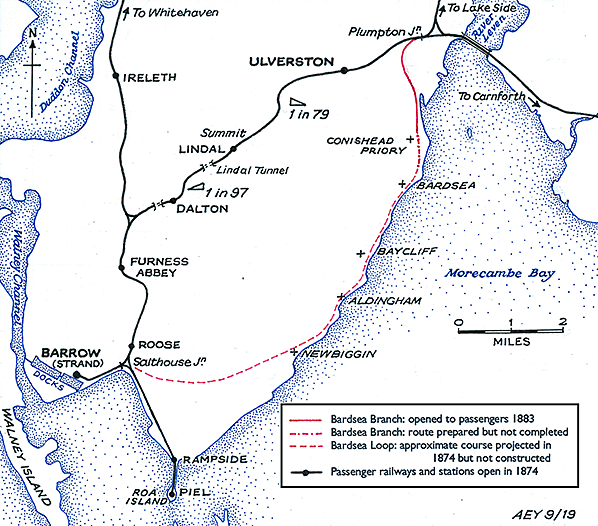
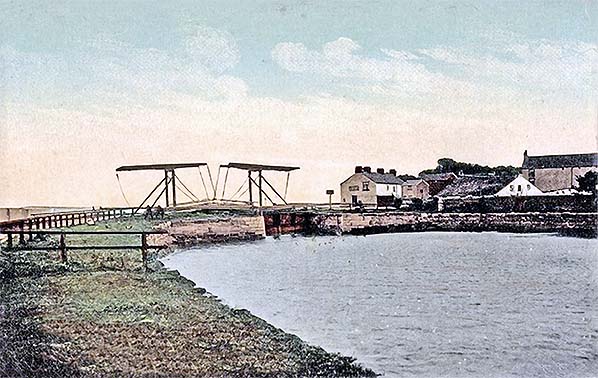 Lock on the Ulverston Canal in the first decade of the twentieth century.
Lock on the Ulverston Canal in the first decade of the twentieth century.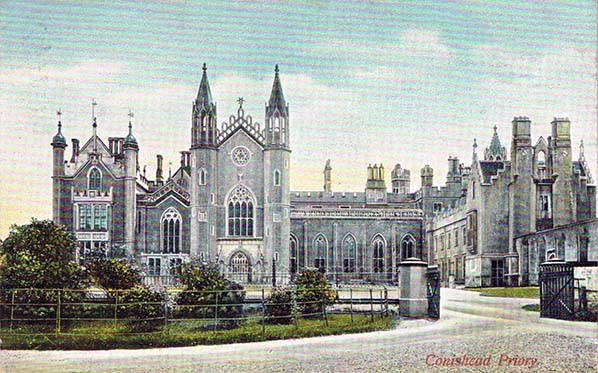
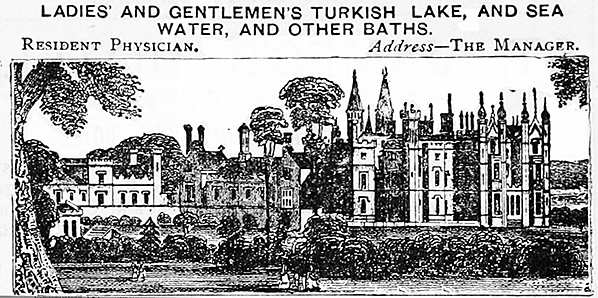 Conishead Priory Hydro in Ward & Locks Guide
Conishead Priory Hydro in Ward & Locks Guide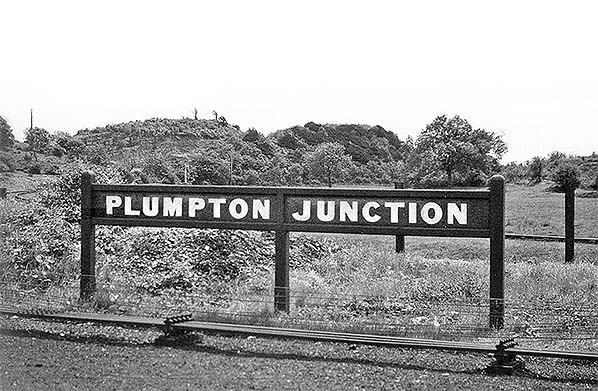 It was unusual prior to the British Rail era for signs to be installed giving the name of junctions where there was no station, unless they were nameboards on adjacent signal boxes. Here is possibly a unique example which was formerly in place at Plumpton Junction. The date of this photo is not known.
It was unusual prior to the British Rail era for signs to be installed giving the name of junctions where there was no station, unless they were nameboards on adjacent signal boxes. Here is possibly a unique example which was formerly in place at Plumpton Junction. The date of this photo is not known.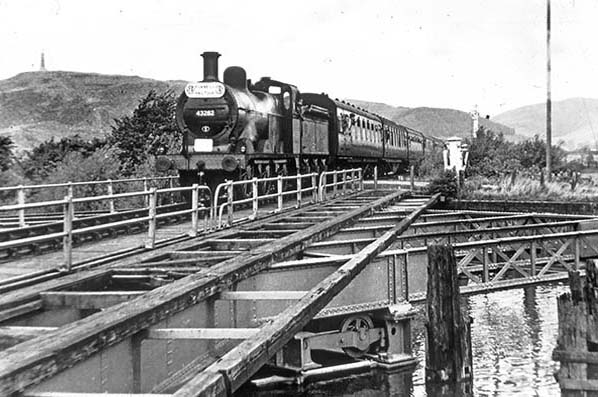 On 27 August 1961 the 'Furness Railtour. Is crossing the 'rolling bridge' over the Ulverston Canal. The train is returning from its visit to North Lonsdale Crossing. The locomotive is Johnson Class 3F 0-6-0 No.43282.
On 27 August 1961 the 'Furness Railtour. Is crossing the 'rolling bridge' over the Ulverston Canal. The train is returning from its visit to North Lonsdale Crossing. The locomotive is Johnson Class 3F 0-6-0 No.43282.

 The mileages given by Bradshaw (above) are incorrect. North Lonsdale Crossing was about 2¾ miles from Ulverston (not ¾) and Conishead Priory a little over 3¾ (not 2). It appears that the mileages were actually calculated from Plumpton Junction and approximated to the nearest quarter-mile.
The mileages given by Bradshaw (above) are incorrect. North Lonsdale Crossing was about 2¾ miles from Ulverston (not ¾) and Conishead Priory a little over 3¾ (not 2). It appears that the mileages were actually calculated from Plumpton Junction and approximated to the nearest quarter-mile.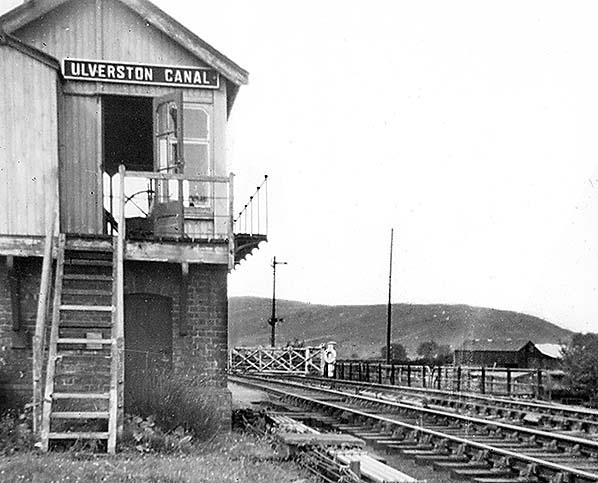 This view northwards is thought to be c1950. The Ulverston Canal signal box seen here was commissioned in December 1931 replacing the box which opened in July 1882, and it appears still to be in use at the time of this photograph. The low fencing beyond the box is on the Canal siding bridge. The level crossing is over the canal tow path. The Canal Branch diverges from the Bardsea Branch a short distance behind the camera and it passes to the left of the signal box.In1952 the line would be singled and converted into a siding and the Canal signal box closed. After this time access to the Canal branch would be by ground frame. The upper part of this box and the frame would be used at Cark & Cartmel to replace a box demolished by a goods train.
This view northwards is thought to be c1950. The Ulverston Canal signal box seen here was commissioned in December 1931 replacing the box which opened in July 1882, and it appears still to be in use at the time of this photograph. The low fencing beyond the box is on the Canal siding bridge. The level crossing is over the canal tow path. The Canal Branch diverges from the Bardsea Branch a short distance behind the camera and it passes to the left of the signal box.In1952 the line would be singled and converted into a siding and the Canal signal box closed. After this time access to the Canal branch would be by ground frame. The upper part of this box and the frame would be used at Cark & Cartmel to replace a box demolished by a goods train.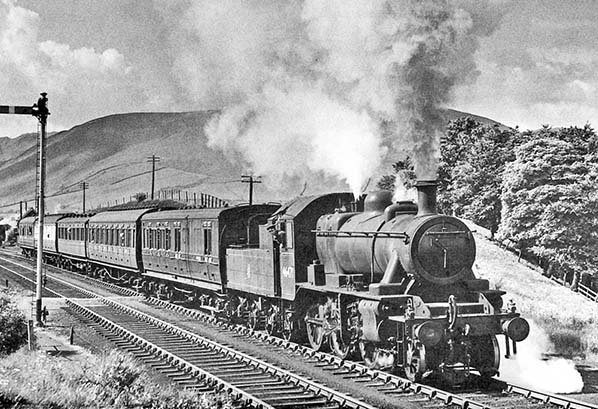 On Friday 6 June 1952 the fortnightly special for injured and convalescing miners is leaving Tebay on the 8.42am Ulverston to Durham train (via the Stainmore route). Ivatt Class 2MT 2-6-0 No.46471 is hauling the train.
On Friday 6 June 1952 the fortnightly special for injured and convalescing miners is leaving Tebay on the 8.42am Ulverston to Durham train (via the Stainmore route). Ivatt Class 2MT 2-6-0 No.46471 is hauling the train.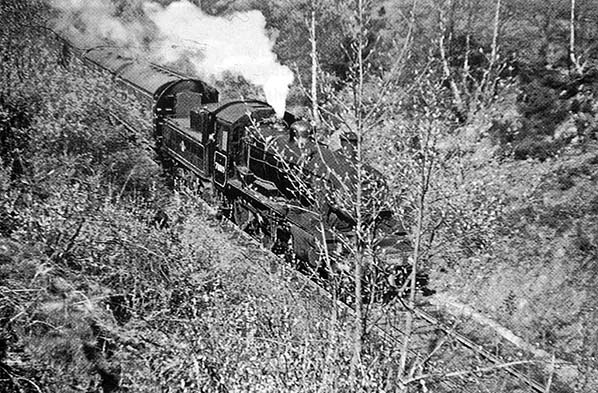 The fortnightly special for Durham miners is seen in Forthburn cutting between Cockfield Fell and Barnard Castle in April 1960. Standard Class 2 2-6-0 No.78019 is hauling the train from Durham to Ulverston.
The fortnightly special for Durham miners is seen in Forthburn cutting between Cockfield Fell and Barnard Castle in April 1960. Standard Class 2 2-6-0 No.78019 is hauling the train from Durham to Ulverston.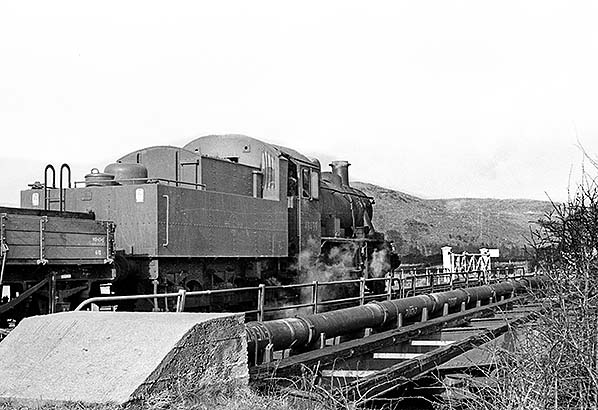 A northbound goods working on the Bardsea Branch and crossing the bridge over the Ulverston Canal. The loco is 2MT 2-6-0 No.46499. After Ulverston Gasworks, which was the last used of the Canal Branch, closed in 1966 Glaxo remained the only user of what was left of the Bardsea Branch; the company purchased the track from British Rail in 1966. This photograph dates from circa 1966.
A northbound goods working on the Bardsea Branch and crossing the bridge over the Ulverston Canal. The loco is 2MT 2-6-0 No.46499. After Ulverston Gasworks, which was the last used of the Canal Branch, closed in 1966 Glaxo remained the only user of what was left of the Bardsea Branch; the company purchased the track from British Rail in 1966. This photograph dates from circa 1966.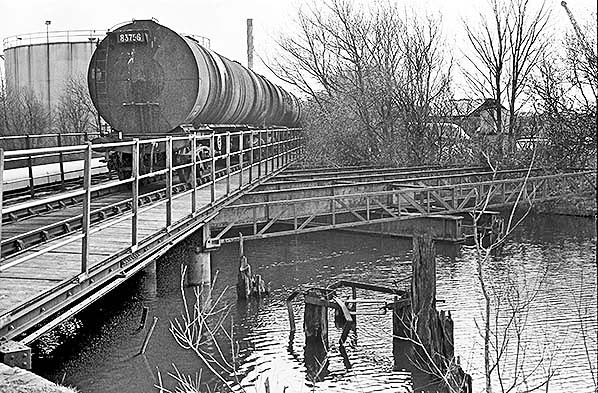 Rail-borne oil tanks on the Ulverston Canal bridge c1990 with the Glaxo pharmaceutical works, for which they are bound, in the background.
Rail-borne oil tanks on the Ulverston Canal bridge c1990 with the Glaxo pharmaceutical works, for which they are bound, in the background.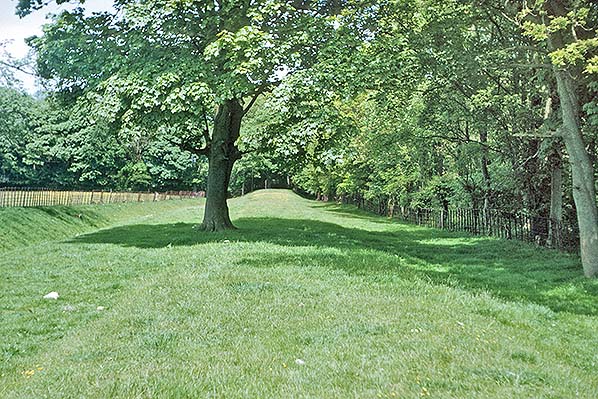 The low embankment south of Conishead Priory station would have taken the line to Bardsea. The embankment was constructed but never had rails.. It is seen in 1975.
The low embankment south of Conishead Priory station would have taken the line to Bardsea. The embankment was constructed but never had rails.. It is seen in 1975.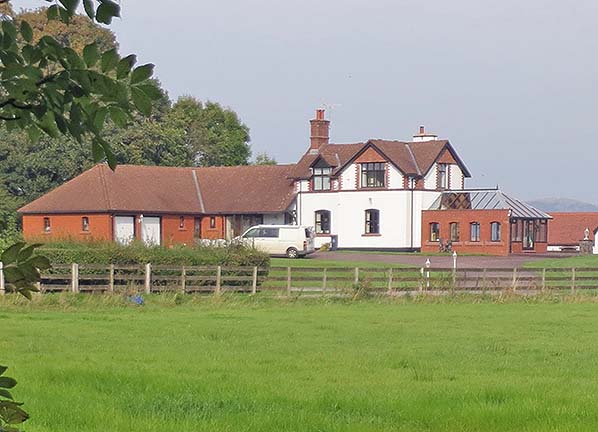
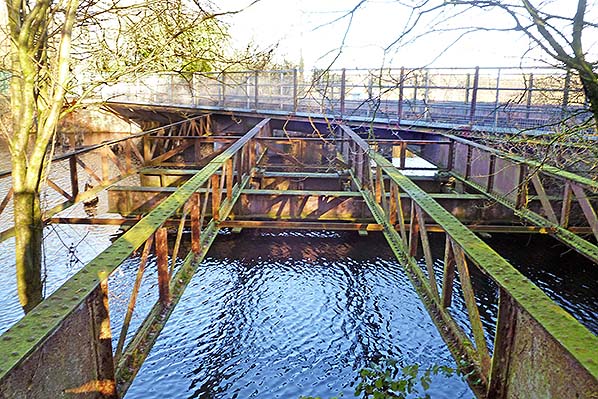 The rolling bridge over the Ulverston Canal is seen on 17 January 2019. The bridge received ‘Listed’ status in 2012 and it carries the Glaxo emergency water supply from Newland Beck and a public pedestrian walkway. It is now in the hands of a new Ulverston Canal Company charged with its preservation.
The rolling bridge over the Ulverston Canal is seen on 17 January 2019. The bridge received ‘Listed’ status in 2012 and it carries the Glaxo emergency water supply from Newland Beck and a public pedestrian walkway. It is now in the hands of a new Ulverston Canal Company charged with its preservation.
 Home Page
Home Page